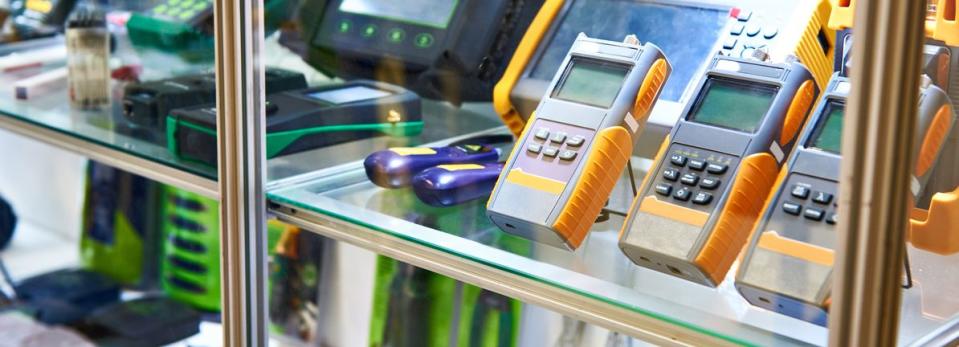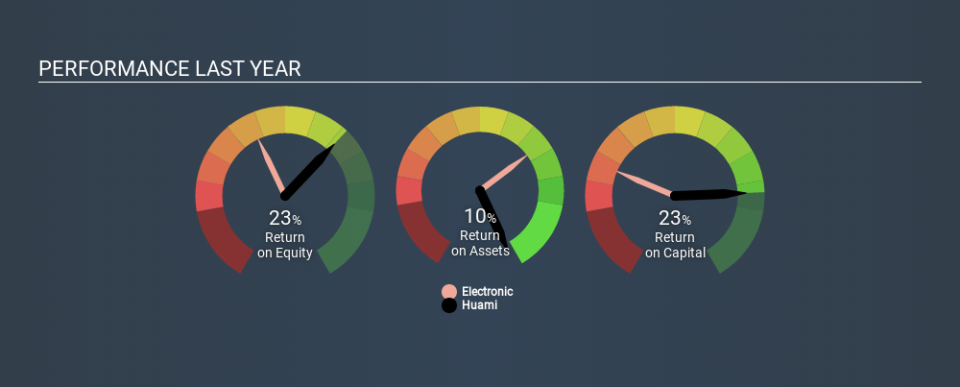Huami Corporation (NYSE:HMI) Earns A Nice Return On Capital Employed

Today we'll evaluate Huami Corporation (NYSE:HMI) to determine whether it could have potential as an investment idea. Specifically, we're going to calculate its Return On Capital Employed (ROCE), in the hopes of getting some insight into the business.
Firstly, we'll go over how we calculate ROCE. Second, we'll look at its ROCE compared to similar companies. And finally, we'll look at how its current liabilities are impacting its ROCE.
Return On Capital Employed (ROCE): What is it?
ROCE is a metric for evaluating how much pre-tax income (in percentage terms) a company earns on the capital invested in its business. Generally speaking a higher ROCE is better. Ultimately, it is a useful but imperfect metric. Renowned investment researcher Michael Mauboussin has suggested that a high ROCE can indicate that 'one dollar invested in the company generates value of more than one dollar'.
So, How Do We Calculate ROCE?
The formula for calculating the return on capital employed is:
Return on Capital Employed = Earnings Before Interest and Tax (EBIT) ÷ (Total Assets - Current Liabilities)
Or for Huami:
0.23 = CN¥606m ÷ (CN¥5.2b - CN¥2.5b) (Based on the trailing twelve months to December 2019.)
Therefore, Huami has an ROCE of 23%.
View our latest analysis for Huami
Does Huami Have A Good ROCE?
ROCE is commonly used for comparing the performance of similar businesses. Using our data, we find that Huami's ROCE is meaningfully better than the 11% average in the Electronic industry. I think that's good to see, since it implies the company is better than other companies at making the most of its capital. Regardless of the industry comparison, in absolute terms, Huami's ROCE currently appears to be excellent.
Our data shows that Huami currently has an ROCE of 23%, compared to its ROCE of 4.0% 3 years ago. This makes us think about whether the company has been reinvesting shrewdly. You can click on the image below to see (in greater detail) how Huami's past growth compares to other companies.
It is important to remember that ROCE shows past performance, and is not necessarily predictive. ROCE can be misleading for companies in cyclical industries, with returns looking impressive during the boom times, but very weak during the busts. This is because ROCE only looks at one year, instead of considering returns across a whole cycle. Future performance is what matters, and you can see analyst predictions in our free report on analyst forecasts for the company.
How Huami's Current Liabilities Impact Its ROCE
Short term (or current) liabilities, are things like supplier invoices, overdrafts, or tax bills that need to be paid within 12 months. Due to the way the ROCE equation works, having large bills due in the near term can make it look as though a company has less capital employed, and thus a higher ROCE than usual. To counter this, investors can check if a company has high current liabilities relative to total assets.
Huami has total assets of CN¥5.2b and current liabilities of CN¥2.5b. Therefore its current liabilities are equivalent to approximately 48% of its total assets. Huami has a medium level of current liabilities, boosting its ROCE somewhat.
What We Can Learn From Huami's ROCE
Despite this, it reports a high ROCE, and may be worth investigating further. Huami shapes up well under this analysis, but it is far from the only business delivering excellent numbers . You might also want to check this free collection of companies delivering excellent earnings growth.
I will like Huami better if I see some big insider buys. While we wait, check out this free list of growing companies with considerable, recent, insider buying.
If you spot an error that warrants correction, please contact the editor at editorial-team@simplywallst.com. This article by Simply Wall St is general in nature. It does not constitute a recommendation to buy or sell any stock, and does not take account of your objectives, or your financial situation. Simply Wall St has no position in the stocks mentioned.
We aim to bring you long-term focused research analysis driven by fundamental data. Note that our analysis may not factor in the latest price-sensitive company announcements or qualitative material. Thank you for reading.

 Yahoo Finance
Yahoo Finance 
